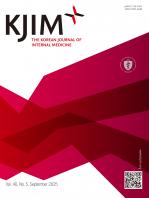|
Nephrology / Image of interest
Leiomyosarcoma at popliteal vein presented as unilateral leg edema in a patient with kidney transplantation
Sang Heon Song
Korean J Intern Med. 2025;40(5):858-859. Published online August 26, 2025
|
|
|
Nephrology / Review
Clinical benefits and future directions of medium cut-off membranes in hemodialysis: a comprehensive review
Hyo Jin Kim, Sang Heon Song
Korean J Intern Med. 2025;40(4):557-570. Published online July 1, 2025
Medium cut-off (MCO) membranes have emerged as a promising innovation in hemodialysis (HD), offering enhanced clearance of large middle-molecules of uremic toxins compared to traditional HD membranes, while maintaining minimal loss of albumin. The introduction of MCO membranes represents a significa..
|
|
|
Nephrology / Review
Steps to understanding diabetes kidney disease: a focus on metabolomics
Hyo Jin Kim, Sang Heon Song
Korean J Intern Med. 2024;39(6):898-905. Published online October 22, 2024
Diabetic nephropathy (DN), a leading cause of chronic kidney disease and end-stage kidney disease (ESKD), poses global health challenges given its increasing prevalence. DN increases the risk of mortality and cardiovascular events. Early identification and appropriate DN management are crucial. Howe..
|
|
|
Nephrology / Image of interest
Primary peritoneal carcinoma presented with abdominal pain in patient with kidney transplantation
Eunmi Jo, Sang Heon Song
Korean J Intern Med. 2024;39(4):693-694. Published online April 29, 2024
|
|
|
Pulmonology / Image of interest
Pregabalin-induced rhabdomyolysis in hemodialysis patient
Dong Eon Kim, Sang Heon Song
Korean J Intern Med. 2024;39(2):366-367. Published online November 30, 2023
|
|
|
Nephrology / Review
Sarcopenia in chronic kidney disease: from bench to bedside
Da Woon Kim, Sang Heon Song
Korean J Intern Med. 2023;38(3):303-321. Published online April 20, 2023
Sarcopenia is a condition characterized by a loss of muscle mass and function. In chronic kidney disease (CKD), where a chronic catabolic state exists, sarcopenia commonly occurs through various mechanisms, resulting in muscle wasting and decreased muscle endurance. Sarcopenic patients with CKD have..
|
|
|
Review
Glomerular filtration rate as a kidney outcome of diabetic kidney disease: a focus on new antidiabetic drugs
Hyo Jin Kim, Sang Soo Kim, Sang Heon Song
Korean J Intern Med. 2022;37(3):502-519. Published online April 4, 2022
Diabetes has reached epidemic proportions, both in Korea and worldwide and is associated with an increased risk of chronic kidney disease and kidney failure (KF). The natural course of kidney function among people with diabetes (especially type 2 diabetes) may be complex in real-world situations. St..
|
|
|
Nephrology / Original Article
Role of Akt1 in renal fibrosis and tubular dedifferentiation during the progression of acute kidney injury to chronic kidney disease
Il Young Kim, Yeon Kyeong Park, Sang Heon Song, Eun Young Seong, Dong Won Lee, Sun Sik Bae, Soo Bong Lee
Korean J Intern Med. 2021;36(4):962-974. Published online December 16, 2020
Background/Aims: Acute kidney injury (AKI) is an underestimated yet important risk factor for the development of chronic kidney disease (CKD), characterized by tubulointerstitial fibrosis and tubular dedifferentiation. Tubular dedifferentiation, which is associated with the loss of epithelial marker..
|
|
|
Infectious diseases / Original Article
Incidence and risk factors for tenofovir-associated nephrotoxicity among human immunodeficiency virus-infected patients in Korea
Jeong Eun Lee, Shinwon Lee, Sang Heon Song, Ihm Soo Kwak, Sun Hee Lee
Korean J Intern Med. 2019;34(2):409-417. Published online October 12, 2017
Background/Aims: Little is known about tenofovir disoproxil fumarate (TDF)-induced nephrotoxicity in human immunodeficiency virus (HIV)-infected patients in Korea. The objective of this study was to evaluate the incidence and risk factors of TDF-associated nephrotoxicity among HIV-infected patients ..
|
|
|
Nephrology / Original Article
High serum and urine neutrophil gelatinase-associated lipocalin levels are independent predictors of renal progression in patients with immunoglobulin A nephropathy
Harin Rhee, Nari Shin, Min Ji Shin, Byung Yun Yang, Il Young Kim, Sang Heon Song, Dong Won Lee, Soo Bong Lee, Ihm Soo Kwak, Eun Young Seong
Korean J Intern Med. 2015;30(3):354-361. Published online April 29, 2015
Background/Aims: Tubulointerstitial injury plays an important role in the progression of immunoglobulin A nephropathy (IgAN), and neutrophil gelatinase-associated lipocalin (NGAL) is among the most sensitive tubular biomarkers. We investigated whether serum or urine NGAL predicts prognosis in patien..
|
|
|
Original Article
Recent clinical overview of renal and perirenal abscesses in 56 consecutive cases
Bong Eun Lee, Hee Yun Seol, Tae Kyung Kim, Eun Young Seong, Sang Heon Song, Dong Won Lee, Soo Bong Lee, Ihm Soo Kwak
Korean J Intern Med. 2008;23(3):140-148. Published online September 20, 2008
Background/AimsThe aim of this study was to examine the recent clinical trends and antibiotic susceptibilities of the causative microorganisms in renal and perirenal abscesses, and to elucidate the factors associated with treatment strategies. ..
|
|
|
















